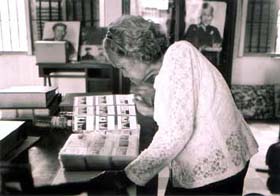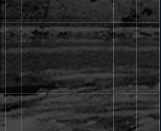|
"At
first, we would have to stop our sessions because we all would become
overwhelmed, but the process of healing became evident. After ten
days in Angkor, the stories became about their return to Phnom Penh.
They had become visibly more confident, almost triumphant. They
had allowed their wounds to open and had accomplished the first
stage of some kind of recovery."
"Upon our return in May, it became evident that the various
physical sites were very powerful because of the memories each would
bring up. In Phnom Penh, we went to the old palace where Em Theay
began her career and to Tuol Sleng, the Khmer Rouge’s detention
and torture center which is now a museum. The walls there are covered
with pictures of their victims, some of whom our artists knew. I
found that the people do not consider it or the Killing Fields,
which is just open space now, memorials for what happened--memorials
meant for them, that is. They feel they have been appropriated by
the present political powers to secure their positions by blaming
everything that’s wrong now on Pol Pot. Our artists said that
many locals have not been to those places. `Too many ghosts,’
they said."

Photo
Copyright@ Valerie Ann Oliveiro |
"When
Pol Pot emptied Phnom Penh, the people were sent to labor camps
in the country, mainly to clear forests for farming. Life was extremely
nomadic. They generally did not live in a particular village but
moved around to locations they cannot recognize now. Of our four
performers, two cannot trace exactly where they were during those
four years. They can’t go back to find the bones of family
and friends who died there. At the time, they weren’t even
allowed to bury their dead. There is a complete erasure of the past."
"Em Theay and her daughter were luckier because they were based
in a particular village in Battambang Province. At the beginning
of the rehearsal process in February, I had suggested that maybe
we could return to that village. At that time, they said they would
rather not unless it was really essential. In May I was amazed that
both Em Theay and Thong Kim Ann had become completely insistent.
It was like they were leading us to the village. They were anxious
finally to tell the story. As with the Chinese Cultural Revolution,
the village farmers were put in charge of the laborers. There had
been a total inversion in the power structure. When we went back,
those farming families were still there. They were also victims
of Pol Pot, of course, but at the same time they had been placed
in disciplinarian positions. Our company met the farmers who had
been in charge of their lives twenty years before and there were
tears of reconciliation. Em Theay showed us where people were killed
and where there are mass graves. She survived precisely because
of her dancing and singing. She was useful entertaining the children
while the rest worked. They all had an urgency to tell us those
stories and now they have the urgency to tell an audience."
|
|


